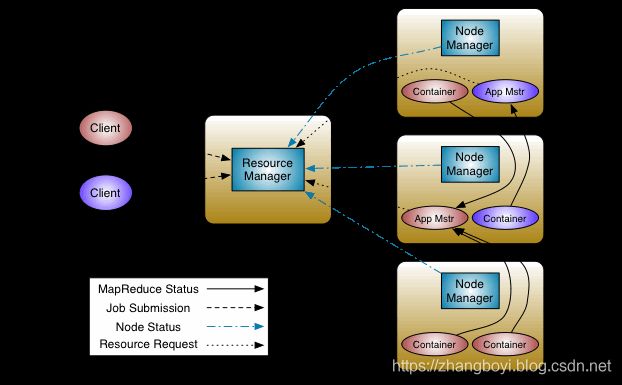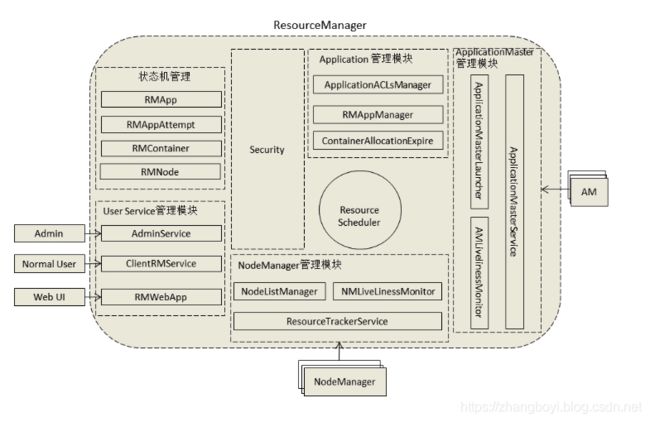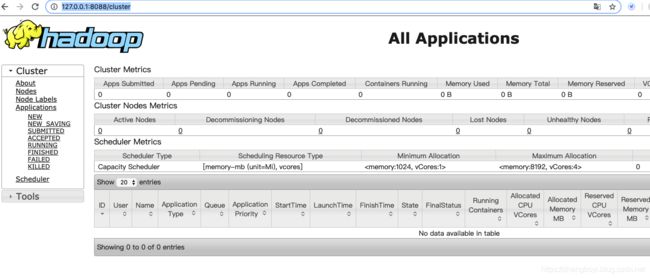Hadoop3.2.0 源码分析: ResourceManager启动
概述
相信开始看源码的你,正在一点点的进入知识的殿堂,一起挖掘吧.
ResourceManager 是Yarn 的资源调度中心,很重要,所有的资源申请都需要通过ResourceManager来调度.
The ResourceManager is the main class that is a set of components.
"I am the ResourceManager. All your resources belong to us..."
这是开头,代码注释的几句话,蛮有意思,就摘抄了一下.
架构图:
启动流程图:
结构图
类图
缩略版
完整版:
代码:
在启动ResourceManager的时候,需要执行脚本: yarn-daemon.sh start resourcemanager
其实就是调用:
org.apache.hadoop.yarn.server.resourcemanager.ResourceManager#main 方法 (无参)
直接查看main 方法:
这里最核心的其实就是, 资源初始化, 与启动服务.
我们看一下,资源初始化操作
resourceManager.init(conf);
在这里,主要关注core-default.xml , core-site.xml , yarn-default.xml , yarn-site.xml 四个配置文件.
其实就是读取这里面的内容,加载到配置里面.
接下来,看初始化方法:
org.apache.hadoop.yarn.server.resourcemanager#serviceInit
@Override
protected void serviceInit(Configuration conf) throws Exception {
this.conf = conf;
// todo RM上下文,存有RM的许多重要成员
this.rmContext = new RMContextImpl();
rmContext.setResourceManager(this);
// todo 配置管理初始化
this.configurationProvider =
ConfigurationProviderFactory.getConfigurationProvider(conf);
this.configurationProvider.init(this.conf);
rmContext.setConfigurationProvider(configurationProvider);
// todo load core-site.xml
loadConfigurationXml(YarnConfiguration.CORE_SITE_CONFIGURATION_FILE);
// Do refreshSuperUserGroupsConfiguration with loaded core-site.xml
// Or use RM specific configurations to overwrite the common ones first
// if they exist
// todo 从已加载的 core-site.xml文件中获取 用户<->组 的映射表
RMServerUtils.processRMProxyUsersConf(conf);
ProxyUsers.refreshSuperUserGroupsConfiguration(this.conf);
// todo load yarn-site.xml
loadConfigurationXml(YarnConfiguration.YARN_SITE_CONFIGURATION_FILE);
//todo 验证
validateConfigs(this.conf);
// todo Set HA configuration should be done before login
// todo 填充是否配置了RM 高可用
this.rmContext.setHAEnabled(HAUtil.isHAEnabled(this.conf));
if (this.rmContext.isHAEnabled()) {
// todo 如果确认配置了RM高可用,就需要验证现有配置的参数是否支持高可用,验证不通过就抛出异常
HAUtil.verifyAndSetConfiguration(this.conf);
}
// Set UGI and do login
// If security is enabled, use login user
// If security is not enabled, use current user
this.rmLoginUGI = UserGroupInformation.getCurrentUser();
try {
doSecureLogin();
} catch(IOException ie) {
throw new YarnRuntimeException("Failed to login", ie);
}
// todo register the handlers for all AlwaysOn services using setupDispatcher().
// todo 注册一个异步Dispatcher,有一个单独的线程来处理所有持续开启的服务的各种EventType。
// todo Yarn中采用了事件驱动的编程模型,后面很多不同的事件都用了这个dispatcher来处理。后面会详细说
rmDispatcher = setupDispatcher();
// todo 将rmDispatcher放到CompositeService的serviceList
addIfService(rmDispatcher);
// todo 并放入RM上下文中
rmContext.setDispatcher(rmDispatcher);
// The order of services below should not be changed as services will be
// started in same order
// As elector service needs admin service to be initialized and started,
// first we add admin service then elector service
// todo 注册管理员服务
// todo AdminService为管理员提供了一套独立的服务接口,以防止大量的普通用户的请求使得管理员发送的管理命令饿死。
// todo 管理员可以通过这些接口命令管理集群,比如动态更新节点列表,更新ACL列表,更新队列信息等
adminService = createAdminService();
addService(adminService);
rmContext.setRMAdminService(adminService);
// elector must be added post adminservice
if (this.rmContext.isHAEnabled()) {
// If the RM is configured to use an embedded leader elector,
// initialize the leader elector.
if (HAUtil.isAutomaticFailoverEnabled(conf)
&& HAUtil.isAutomaticFailoverEmbedded(conf)) {
EmbeddedElector elector = createEmbeddedElector();
addIfService(elector);
rmContext.setLeaderElectorService(elector);
}
}
rmContext.setYarnConfiguration(conf);
//todo 创建activeServices
createAndInitActiveServices(false);
webAppAddress = WebAppUtils.getWebAppBindURL(this.conf,
YarnConfiguration.RM_BIND_HOST,
WebAppUtils.getRMWebAppURLWithoutScheme(this.conf));
// todo 持久化RMApp, RMAppAttempt, RMContainer的信息
RMApplicationHistoryWriter rmApplicationHistoryWriter =
createRMApplicationHistoryWriter();
addService(rmApplicationHistoryWriter);
rmContext.setRMApplicationHistoryWriter(rmApplicationHistoryWriter);
// initialize the RM timeline collector first so that the system metrics
// publisher can bind to it
if (YarnConfiguration.timelineServiceV2Enabled(this.conf)) {
RMTimelineCollectorManager timelineCollectorManager =
createRMTimelineCollectorManager();
addService(timelineCollectorManager);
rmContext.setRMTimelineCollectorManager(timelineCollectorManager);
}
// todo 生产系统指标数据
SystemMetricsPublisher systemMetricsPublisher =
createSystemMetricsPublisher();
addIfService(systemMetricsPublisher);
rmContext.setSystemMetricsPublisher(systemMetricsPublisher);
registerMXBean();
// todo 接着调用父类CompositeService的serviceInit方法,将他管理的服务全部初始化
super.serviceInit(this.conf);
}
代码比较长, 我挑重点讲解一下.
读取core-default.xml , core-site.xml , yarn-default.xml , yarn-site.xml 这四个文件参数.我就不细说了.
核心 : setupDispatcher , createScheduler(下一篇文章讲解)
实际上就是通过createDispatcher()方法创建了一个 AsyncDispatcher 实例,代码如下:
/**
* Register the handlers for alwaysOn services
*/
private Dispatcher setupDispatcher() {
//todo 设置Dispatcher
//todo 实际上就是通过createDispatcher()方法创建了一个 AsyncDispatcher 实例,代码如下:
Dispatcher dispatcher = createDispatcher();
dispatcher.register(RMFatalEventType.class,
new ResourceManager.RMFatalEventDispatcher());
return dispatcher;
}
在这里需要对 AsyncDispatcher 进行分析 , 代码其实就是一个事件类型的生产者消费者模型.
架构图如下:
我罗列一下重点常量:
private static final Log LOG = LogFactory.getLog(AsyncDispatcher.class);
// todo 待调度处理事件阻塞队列
// todo 调用有参构造函数的时候初始化,传入线程安全的链式阻塞队列LinkedBlockingQueue实例
private final BlockingQueue eventQueue;
private volatile int lastEventQueueSizeLogged = 0;
// todo AsyncDispatcher是否停止的标志位
private volatile boolean stopped = false;
// Configuration flag for enabling/disabling draining dispatcher's events on
// stop functionality.
// todo 在stop功能中开启/禁用流尽分发器事件的配置标志位
private volatile boolean drainEventsOnStop = false;
// Indicates all the remaining dispatcher's events on stop have been drained
// and processed.
// todo stop功能中所有剩余分发器事件已经被处理或流尽的标志位
private volatile boolean drained = true;
// todo drained的等待锁
private final Object waitForDrained = new Object();
// For drainEventsOnStop enabled only, block newly coming events into the
// queue while stopping.
// todo 在AsyncDispatcher停止过程中阻塞新近到来的事件进入队列的标志位,仅当drainEventsOnStop启用(即为true)时有效
private volatile boolean blockNewEvents = false;
// todo 事件处理器实例
private final EventHandler handlerInstance = new GenericEventHandler();
private Thread eventHandlingThread;
// todo 类型为: HashMap, EventHandler>();
protected final Map, EventHandler> eventDispatchers;
// todo 标志位:确保调度程序崩溃,但不做系统退出system-exit
private boolean exitOnDispatchException = true;
BlockingQueue
然后有队列了, 就需要生产者和消费者.
先看消费者: createThread 这个方法,就说明了如何消费队列中的数据.
这里面有个点要说明一下, 当服务停止的时候,并不是立马中断. 而是要干两件事.
1.停止接受新的任务.
2.等待队列中的任务处理,完成. 最大等待时间 5min.
@Override
protected void serviceStart() throws Exception {
//start all the components
super.serviceStart();
// todo 创建事件处理调度线程 eventHandlingThread
// todo createThread !!!!!!!!!!!!!
eventHandlingThread = new Thread(createThread());
// todo 设置线程名为AsyncDispatcher event handler
eventHandlingThread.setName(dispatcherThreadName);
// todo 启动事件处理调度线程eventHandlingThread
eventHandlingThread.start();
}
Runnable createThread() {
return new Runnable() {
@Override
public void run() {
//todo 如果不是停止, 或者当前线程不被中断.
while (!stopped && !Thread.currentThread().isInterrupted()) {
//todo 判断事件调度队列eventQueue是否为空,并赋值给标志位drained
drained = eventQueue.isEmpty();
// blockNewEvents is only set when dispatcher is draining to stop,
// adding this check is to avoid the overhead of acquiring the lock
// and calling notify every time in the normal run of the loop.
// todo 如果停止过程中阻止新的事件加入待处理队列,即标志位blockNewEvents为true
if (blockNewEvents) {
//todo 在这里面有锁
synchronized (waitForDrained) {
if (drained) {
// todo 如果待处理队列中的事件都已调度完毕,调用waitForDrained的notify()方法通知等待者
waitForDrained.notify();
}
}
}
Event event;
try {
//todo 获取事件
// todo 从事件调度队列eventQueue中取出一个事件
// todo take()方法为取走BlockingQueue里排在首位的对象,若BlockingQueue为空,阻塞进入等待状态直到 BlockingQueue有新的数据被加入
event = eventQueue.take();
} catch(InterruptedException ie) {
if (!stopped) {
LOG.warn("AsyncDispatcher thread interrupted", ie);
}
return;
}
// todo 如果取出待处理事件event,即不为null
if (event != null) {
//todo 调度事件event 调用dispatch()方法进行分发
dispatch(event);
}
}
}
};
}
在这里,拿到事件之后会调用 dispatch 方法.
其实就是根据传入时间的类型, 去内存中寻找对应类型的事件处理方法.进行处理.
//todo 这个是事件调度方法 dispatch
@SuppressWarnings("unchecked")
protected void dispatch(Event event) {
//all events go thru this loop
if (LOG.isDebugEnabled()) {
LOG.debug("Dispatching the event " + event.getClass().getName() + "."
+ event.toString());
}
// todo 根据事件event获取事件类型枚举类type
Class type = event.getType().getDeclaringClass();
try{
//todo 获取事件类型所对应的Handler
EventHandler handler = eventDispatchers.get(type);
if(handler != null) {
//todo 调用对应的 handler 来处理事件.
handler.handle(event);
} else {
// todo 否则抛出异常,提示针对事件类型type的事件处理器handler没有注册
throw new Exception("No handler for registered for " + type);
}
} catch (Throwable t) {
//TODO Maybe log the state of the queue
LOG.fatal("Error in dispatcher thread", t);
// If serviceStop is called, we should exit this thread gracefully.
if (exitOnDispatchException
&& (ShutdownHookManager.get().isShutdownInProgress()) == false
&& stopped == false) {
stopped = true;
Thread shutDownThread = new Thread(createShutDownThread());
shutDownThread.setName("AsyncDispatcher ShutDown handler");
shutDownThread.start();
}
}
} 接下来是消费者: GenericEventHandler , 就是向队列中添加事件而已.
// todo 事件处理器实例
private final EventHandler handlerInstance = new GenericEventHandler();
//todo 默认的通用事件处理 --产生数据
class GenericEventHandler implements EventHandler {
public void handle(Event event) {
// todo 如果blockNewEvents为true,即AsyncDispatcher服务停止过程正在发生,
// todo 且阻止新的事件加入待调度处理事件队列eventQueue,直接返回
if (blockNewEvents) {
return;
}
// todo 标志位drained设置为false,说明队列中尚有事件需要调度
drained = false;
/* all this method does is enqueue all the events onto the queue */
// todo 获取队列eventQueue大小qSize
int qSize = eventQueue.size();
// todo 每隔1000记录一条info级别日志信息,比如:Size of event-queue is 2000
if (qSize != 0 && qSize % 1000 == 0
&& lastEventQueueSizeLogged != qSize) {
lastEventQueueSizeLogged = qSize;
LOG.info("Size of event-queue is " + qSize);
}
// todo 获取队列eventQueue剩余容量remCapacity
int remCapacity = eventQueue.remainingCapacity();
// todo 如果剩余容量remCapacity小于1000,记录warn级别日志信息,
// 比如:Very low remaining capacity in the event-queue: 888
if (remCapacity < 1000) {
LOG.warn("Very low remaining capacity in the event-queue: "
+ remCapacity);
}
try {
// todo 队列eventQueue中添加事件event
eventQueue.put(event);
} catch (InterruptedException e) {
if (!stopped) {
LOG.warn("AsyncDispatcher thread interrupted", e);
}
// Need to reset drained flag to true if event queue is empty,
// otherwise dispatcher will hang on stop.
drained = eventQueue.isEmpty();
throw new YarnRuntimeException(e);
}
};
}
服务初始化完成之后,就需要启动服务.
resourceManager.start();
在这里面核心的是: serviceStart 方法. 我直接罗列父类的方法. 其实就是循环启动服务而已.
子类有自定义的方法, 单最终都会调用父类的方法.有时间,可以自己去看,
//todo 获取所有的服务 其实就是一个 ArrayList
List services = getServices();
if (LOG.isDebugEnabled()) {
LOG.debug(getName() + ": starting services, size=" + services.size());
}
for (Service service : services) {
// start the service. If this fails that service
// will be stopped and an exception raised
//todo 循环启动
service.start();
}
super.serviceStart();
然后坐等服务启动完成.
http://127.0.0.1:8088/cluster
如果有不正确的地方, 请指正,不胜感激................







